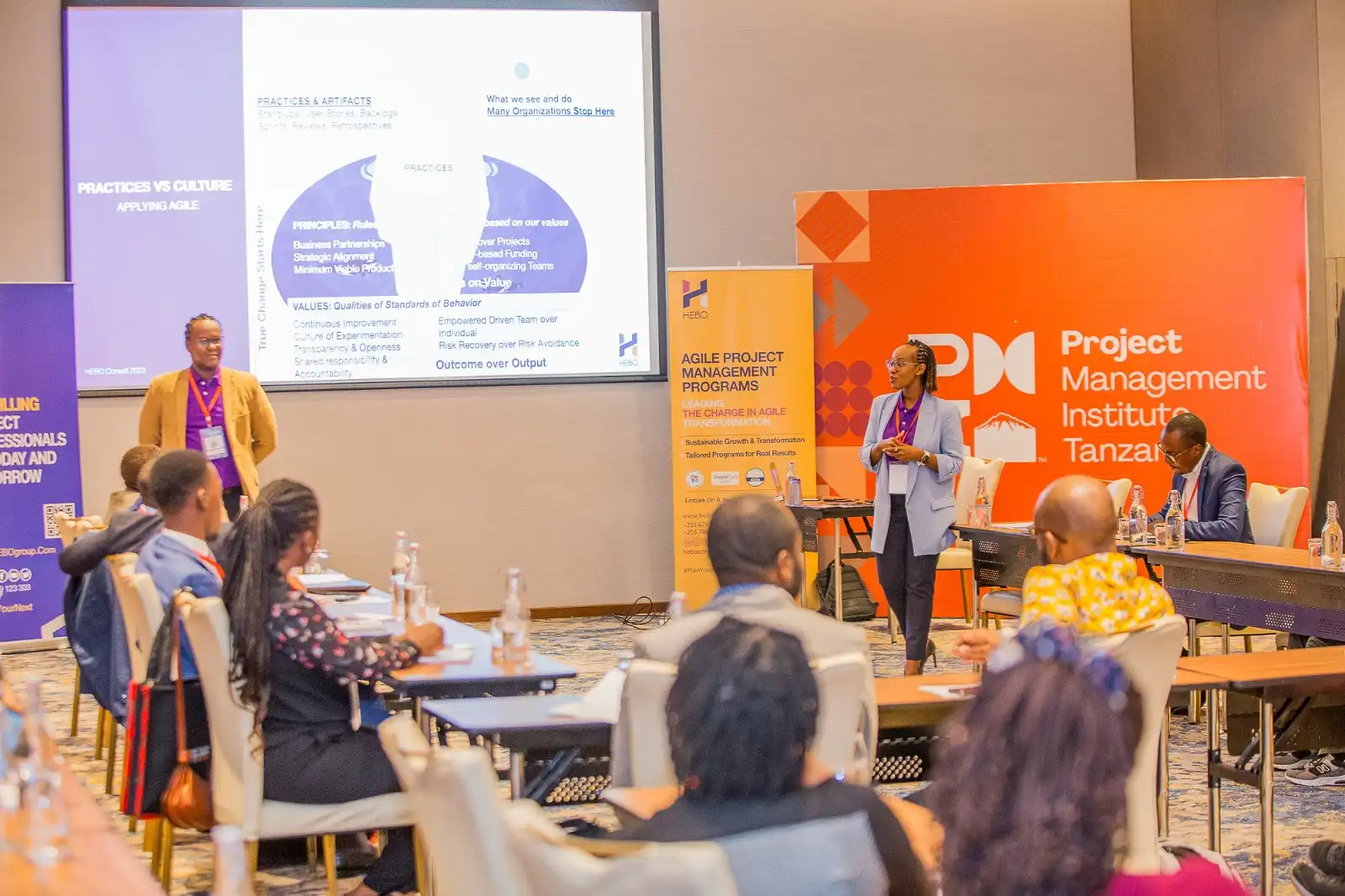“To be agile, being fluent in only one way of working is not enough. Project Professionals must develop the ability to choose the right approach, or even combine several approaches, depending on the context”
The PMI Agile Certified Practitioner (PMI-ACP® )sets the standard for agility in the project management profession. This certification embodies the rigorous standards and recognition the PMI® is known for, coupled with the fluid and adaptive methods of agile.
By achieving the PMI-ACP® certification, you demonstrate a deep commitment to agile practices, rooted not just in theory, but in real-world application. This certification is evidence of your ability to combine traditional project management skills with agile tools and techniques.
PMI-ACP® Examination Content Outline (ECO)
PMI provides potential exam takers with the ”PMI – ACP® Exam Content Outline” (ECO) as a resource. This outline is a content source for
The PMI – ACP® exam questions
Outline your PMI – ACP® exam prep plans
Understanding the PMI-ACP® Certification
This certification encompasses a wide array of agile methodologies, including Scrum, Kanban, Lean, extreme programming (XP), and test-driven development (TDD). With its emphasis on iterative development, continuous feedback, and adaptability, PMI-ACP certified professionals drive projects with an eye for efficiency, quality, and customer satisfaction.
Being agile isn’t just about speed; it’s about working smarter, responding quickly to the market, and ensuring stakeholder satisfaction. With PMI-ACP, you validate your ability to understand and enact these principles.
Why Embrace Agile?
Agile methodologies promote a project management process that encourages frequent inspection and adaptation. It fosters a collaborative environment where cross-functional teams can work together to iterate on a project in smaller, manageable bursts, or “sprints.”
Benefits include:
Swift Response
Agile organizations can quickly pivot in response to market changes or new information.
Collaboration
Agile promotes a hands-on approach from all stakeholders, enhancing the end product’s quality and relevance.
Optimal Productivity
Agile practices reduce overhead and streamline project delivery, ensuring value delivery at every stage.
The PMI-ACP® Advantage
While Agile principles might seem straightforward, effectively applying them demands deep understanding and expertise. The PMI-ACP® certification not only validates your knowledge in Agile practices but also:
Highlights your commitment to professional excellence.
Demonstrates your capability in integrating Agile practices in project management.
Sets you apart in the competitive job market.
HEBO PMI-ACP® Training Program
We at HEBO Consult are committed to your success. Our PMI-ACP® training program is meticulously designed, keeping the latest PMI-ACP® Exam Content in view. More than just a course, we offer mentorship, ensuring you’re not just prepared but also confident when you face the exam.
This comprehensive training provides you with the requisite 21 contact hours, an essential criterion for the PMI-ACP® exam.
21 contact hours
4 – practice tests
Support in the exam application form
1- mock exam
Am I Eligible?
If you’re considering the PMI-ACP® certification, ensure you meet the following prerequisites:
Secondary diploma (high school diploma, GED, associate’s degree or global equivalent)
12 months of general project experience within the last 5 years (a current PMP® or PgMP® satisfies this requirement but is not mandatory)
8 months of agile project experience within the last 3 years.
Completion of 21 contact hours PMI – ACP® course training, specifically from HEBO Consult, a PMI Authorized Training Partner.
Course Content
The PMI-ACP® Course Training is divided into the following outline.
Domain 1 Mindset – 28%
Agile practitioners should have a deep understanding of the agile mindset and principles and the ability to apply them in practice. They should be able to create an environment that fosters innovation, experimentation, and continuous learning.
Additionally, they should be able to promote collaboration and teamwork, establish a shared vision and working agreements, and develop high-performing
teams.
They should also be able to use retrospective findings to improve the team and breakdown silos. Finally, agile practitioners should be able to evaluate the team’s understanding of agile and tailor the approach accordingly, as well as identify the appropriate inter-team coordination approach.
Task 1: Experiment Early
- Build an increment of the product to validate solution and/or market need
- Create an environment to innovate, learn, and grow
Task 2: Embrace Agile Mindset
- Use agile values and principles
- Integrate agile models based on needs (e.g., use case, team, project, organization)
- Apply the appropriate complexity method/domain to the complexity theory system (i.e. CAS, Stacey Matrix, Cynefin) to classify scenarios
- Identify the application and importance or risks of each complexity system theory given a specific scenario
- Interpret the output of agile suitability tools
Task 3: Promote Collaborative Team Environment
- Establish team vision and working agreements approach (e.g., scrum of scrums, team of teams)
- Form and develop a high performing team
- Use retrospective findings to improve the team
- Use collaboration practices to breakdown silos
- Commit to the team’s decisions even in disagreement
- Evaluate the team’s understanding of agile to tailor the agile approach
- Identify the key factors to consider when determining the appropriate inter-team coordination
Task 4: Build Transparency
- Make status, progress, process, risks, impediments, and learning accessible to all (e.g., using information radiators)
- Define communication strategies for co-located and distributed teams
- Establish a feedback loop for team
Task 5:Foster Psychological Safety
- Promote a no blame culture by encouraging objectivity
- Encourage challenging the status quo
- Encourage dialogue over debate
Task 6: Shorten Feedback Loops
- Include the stakeholders from day one
- Maximize value given a specific timeframe
- Use tools and techniques to shorten feedback (e.g., design thinking and lean startup)
Task 7: Embrace Change
- Promote a growth mindset to respond to change
- Adapt to product needs based on the learning and feedback
- Embrace process adaptation by responding to changing requirements and priorities
- Encourage and model cross skills (e.g., generalizing specialists)
Domain 2 Leadership – 25%
Agile practitioners should possess the necessary skills and knowledge to effectively lead within an agile team. This includes a deep understanding of agile principles and methodologies and the ability to create a collaborative team environment that fosters innovation, learning, and growth.
They should also be able to apply principles of systems thinking to classify scenarios and identify the importance or risks of each classification. Additionally, they should be able to interpret the output of agile suitability tools and integrate agile models based on needs.
Other key skills include the ability to establish team vision and working agreements, form and develop high-performing teams, use retrospective findings to improve the team, and use collaboration practices to break down silos.
They should also be committed to the team’s decisions even in disagreement and be able to evaluate the team’s understanding of
agile to tailor the approach.
Task 1: Empower Teams
- Establish an environment of trust (e.g., enable transparent communication)
- Interpret the output of self-assessment tools and techniques to help teams develop their capabilities
- Motivate team members (e.g., to experiment and/or take risks)
- Coach and mentor team members
- Promote collective ownership of goals
- Recognize the differences between training, coaching, and mentoring and when to apply each approach
- Apply emotional intelligence techniques to support the team, increase empathy, resolve conflict and support positive influence
- Interpret non-verbal cues during team interaction
Task 2: Facilitate Problem Resolution
- Investigate the root cause of problems (e.g., root cause analysis, Ishikawa)
- Ensure the problems are resolved in a timely manner
- Determine the resolution strategies with the team that will add the most value
Task 3: Promote Knowledge Sharing
- Create environment to capture and share knowledge (e.g., Lessons Learned for continuous improvement, retrospectives, communities of practice)
- Allocate time for knowledge sharing and making required updates
- Leverage organizational knowledge assets (e.g., from other similar initiatives, people and processes)
Task 4: Promote agile mindset principles and practices
- Create awareness around the agile values and principles
- Recognize, reward, and encourage agile behavior
- Foster an environment for continuous improvement
Task 5: Promote shared vision and purpose
- Define and ensure there is a common understanding of the purpose and vision with all stakeholders
- Continuously communicate the vision and purpose
- Ensure product is always aligned to the vision and organizational goals
Task 6: Facilitate conflict management
- Identify the root cause and the level of the conflict
- Promote collaborative approach to solve the conflict
Domain 3 Product – 19%
Agile practitioners should have a deep understanding of agile methodologies, including (but not limited to): Scrum, Kanban, and Lean, and be able to apply them to project management and product development. They should have experience in product development, building product roadmaps, creating user stories, and managing product backlogs.
They should have foundational technical knowledge and be able to work closely with development teams to understand technical requirements and constraints. Practitioners should have excellent communication skills and be able to effectively communicate with stakeholders, including customers, development teams, and executives.
The candidate should have strong leadership skills and be able to lead cross-functional teams to deliver high-quality products. Additionally, they should be committed to continuous learning and be willing to stay up to date with the latest trends and best practices in agile project and product management and development.
Task 1: Refine product backlog
- Clarify the backlog items
- Use tools and techniques to collectively size work
- Prioritize the backlog items with the customer/stakeholder
- Decompose the backlog items as needed
Task 2: Manage increments
- Ensure increment is aligned with business priorities
- Measure the delivery of value
- Define the increment goals
- Demonstrate increments of value for early feedback
Task 3: Visualize work
- Educate work visualization techniques
- Continuously share information
- Establish a process to update the data/stats
Task 4: Manage value delivery
- Define what value will look like (e.g., success criteria, sustainability, security, privacy, regulatory, compliance)
- Ensure that the targeted results are achieved (e.g., Customer satisfaction, increase in sales)
- Ensure the value increments are optimized
Domain 4 Delivery – 28%
Agile practitioners should have the necessary skills and knowledge to effectively manage and deliver projects and products using agile approaches. The candidate should have strong communication and collaboration skills to work effectively with cross-functional teams. Experience in agile project management tools and techniques such as user stories, sprint planning, and retrospectives.
Knowledge of agile development practices such as continuous integration, continuous delivery, and test-driven development. Familiarity with agile frameworks and methodologies, but not limited to, such as Scrum, Kanban, SAFe, and Lean. Ability to adapt to changing requirements and priorities in a fast-paced environment. Experience in using agile metrics to measure project progress and
success. Seeking early feedback from internal and external customers to ensure alignment with their needs. Managing risks proactively to minimize impact on project and/or product delivery. Eliminating waste by focusing on delivering value to the customer.
Performing continuous improvement to enhance project delivery and team performance. Engaging customers throughout the project to ensure their needs are met. Optimizing flow by focusing on delivering value quickly and efficiently. In addition, agile practitioners should also have a strong commitment to continuous learning and improvement and a passion for delivering high-quality products
and services to customers
Task 1: Seek early feedback
- Evaluate customer satisfaction
- Collect and incorporate stakeholders’ feedback on a regular basis
- Deliver work in small increments
Task 2: Manage agile metrics
- Determine which metrics are appropriate for a given audience
- Use metrics insights for decision making
- Radiate metrics across the relevant audience
- Review and analyze metrics
Task 3: Manage impediments and risk
- Proactively identify risks and impediments
- Use lessons learned to avoid risks/impediments recurrence
- Engage the team to find the most appropriate course of action
- Prioritize impediment removal and risk mitigation activities
Task 4: Recognize and eliminate waste
- Visualize the end-to-end flow of value in the system (e.g., value added, non-value added)
- Iterate on identification and reduction of waste
- Use metrics, tools and feedback loops to identify waste
- Prioritize waste reduction activities
Task 5: Perform continuous improvements
- Obtain metrics and feedback to drive continuous improvements
- Evaluate the effectiveness of process improvement
- Implement improvement actions
Task 6: Actively engage customers
- Identify and analyze customer and their needs
- Encourage collaboration between customer and team
- Validate that iteration deliverables meet acceptance criteria
Task 7: Optimize flow
- Limit work-in-progress at all levels
- Shield team from interruptions (e.g., create team interfaces)
- Use metrics to analyze and improve flow
Lorem ipsum dolor sit amet, consectetur adipiscing elit. Ut elit tellus, luctus nec ullamcorper mattis, pulvinar dapibus leo.
Lorem ipsum dolor sit amet, consectetur adipiscing elit. Ut elit tellus, luctus nec ullamcorper mattis, pulvinar dapibus leo.
Lorem ipsum dolor sit amet, consectetur adipiscing elit. Ut elit tellus, luctus nec ullamcorper mattis, pulvinar dapibus leo.
Upcoming PMI-ACP® Classes
Register here for upcoming PMI-ACP® training classes
Group Training
Do you have unique needs for your team and are interested in training as a group? With group training, you will enjoy a tailored learning experience and favorably discounted rates to fit your budget and team dynamics.
What you will get in this program?
Official Course Material
Practice tests for the Exam
Certificate (35 Contact Hours )
Student Handbook
PMI® Certified and experienced Instructors
Active Study Group
What do you need to prepare for this course?
Reliable internet access
A free account with PMI®
A computer with headset and microphone
Access to Microsoft Office applications
PMI-ACP® – FAQs
Other Certifications Programs
With Project Management certifications designed for all experience levels, there’s always an optimal next step to enhance and accelerate your career.


